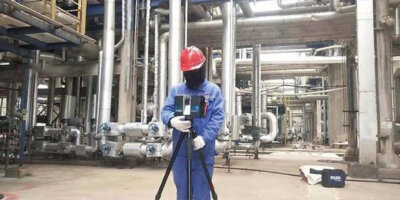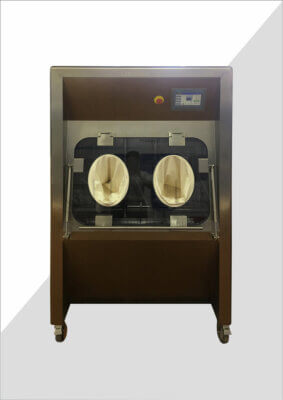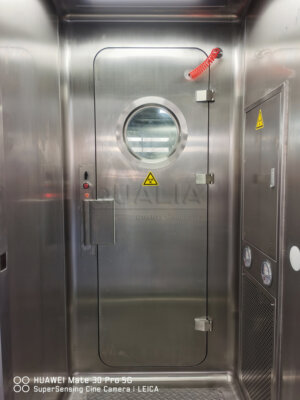In an era where biological hazards pose significant threats to public health and the environment, the importance of effective effluent decontamination systems for high-risk biological waste cannot be overstated. These sophisticated systems play a crucial role in neutralizing dangerous pathogens and ensuring the safe disposal of potentially harmful biological materials. From research laboratories to healthcare facilities, the proper management of biohazardous waste is essential for preventing the spread of diseases and protecting both workers and communities.
The field of effluent decontamination has witnessed remarkable advancements in recent years, with cutting-edge technologies emerging to address the complex challenges posed by various types of biological waste. This article delves into the world of effluent decontamination systems, exploring their critical functions, diverse methodologies, and the latest innovations driving the industry forward. We'll examine the key components of these systems, regulatory standards governing their use, and the importance of tailored solutions for different biosafety levels.
As we navigate through the intricacies of effluent decontamination, we'll uncover the vital role these systems play in maintaining biosafety protocols and environmental integrity. From thermal inactivation to chemical treatment methods, each approach offers unique advantages in neutralizing harmful microorganisms and ensuring the safe release of treated effluents. By understanding the principles behind these systems, we can appreciate their significance in safeguarding public health and advancing scientific research in high-risk biological environments.
Effluent decontamination systems are essential for the safe handling and disposal of high-risk biological waste, employing advanced technologies to neutralize pathogens and protect public health and the environment.
Table: Overview of Effluent Decontamination Methods
| Method | Principle | Advantages | Limitations |
|---|---|---|---|
| Thermal | Heat inactivation | Highly effective, no chemicals | High energy consumption |
| Chemical | Disinfectant treatment | Versatile, cost-effective | Chemical handling risks |
| Thermochemical | Combined heat and chemical | Enhanced efficacy | Complex operation |
| Filtration | Physical removal | No by-products | Limited pathogen range |
| UV Irradiation | DNA/RNA damage | Chemical-free, low maintenance | Dependent on effluent clarity |
What are the fundamental principles of effluent decontamination?
Effluent decontamination systems operate on the fundamental principle of rendering biohazardous waste safe for disposal or release into the environment. These systems are designed to inactivate or destroy pathogenic microorganisms, including bacteria, viruses, and other potentially harmful biological agents present in liquid waste streams.
At its core, effluent decontamination involves subjecting the waste to conditions that are lethal to microorganisms. This can be achieved through various methods, including thermal treatment, chemical disinfection, or a combination of both. The goal is to reduce the microbial load to a level that is considered safe according to regulatory standards and biosafety requirements.
The effectiveness of effluent decontamination systems depends on several factors, including the type and concentration of pathogens present, the volume of waste being treated, and the specific method of inactivation employed. QUALIA offers advanced effluent decontamination systems that are tailored to meet the stringent requirements of biosafety levels 2, 3, and 4, ensuring comprehensive protection against a wide range of biological hazards.
Effluent decontamination systems must achieve a minimum 6-log reduction in viable microorganisms to be considered effective for high-risk biological waste treatment.
| Biosafety Level | Pathogen Risk | Decontamination Requirements |
|---|---|---|
| BSL-2 | Moderate | Chemical treatment or heat inactivation |
| BSL-3 | High | Validated thermal or thermochemical methods |
| BSL-4 | Extreme | Rigorous, multi-stage decontamination |
How do thermal inactivation methods work in effluent decontamination?
Thermal inactivation is one of the most reliable and widely used methods in effluent decontamination systems. This approach harnesses the power of heat to destroy pathogenic microorganisms, rendering them non-viable and safe for disposal. The principle behind thermal inactivation is straightforward: expose the biological waste to temperatures high enough to denature proteins and nucleic acids essential for microbial survival.
In practice, thermal inactivation systems typically use steam or superheated water to achieve the required temperatures. These systems can be designed as batch processors or continuous flow systems, depending on the volume and nature of the waste being treated. The effectiveness of thermal inactivation is largely dependent on three key factors: temperature, time, and pressure.
Advanced thermal inactivation systems, such as those provided by QUALIA, incorporate precise temperature controls and monitoring systems to ensure that every part of the waste stream is subjected to the required conditions for complete pathogen inactivation. These systems often include built-in validation processes to verify the efficacy of the treatment.
Thermal inactivation methods in effluent decontamination systems typically require temperatures of 121°C (250°F) or higher, maintained for at least 30 minutes, to ensure complete sterilization of high-risk biological waste.
| Temperature (°C) | Exposure Time (minutes) | Efficacy Level |
|---|---|---|
| 121 | 30 | Standard sterilization |
| 134 | 18 | Enhanced sterilization |
| 140 | 8 | Rapid sterilization |
What role do chemical treatments play in effluent decontamination?
Chemical treatments play a crucial role in effluent decontamination systems, offering a versatile and often cost-effective approach to neutralizing biological hazards. These methods involve the addition of powerful disinfectants or oxidizing agents to the waste stream, effectively destroying or inactivating pathogenic microorganisms through chemical reactions.
The choice of chemical agent depends on various factors, including the types of pathogens present, the volume of waste, and the specific requirements of the facility. Common chemical treatments include chlorination, ozonation, and the use of peracetic acid or hydrogen peroxide. Each of these agents has its own mechanism of action, targeting different cellular components of microorganisms to render them harmless.
One of the advantages of chemical treatments is their ability to be easily integrated into existing waste management systems. QUALIA offers advanced chemical treatment options as part of their comprehensive effluent decontamination solutions, ensuring efficient and reliable disinfection of high-risk biological waste.
Chemical treatments in effluent decontamination systems can achieve a 4-log to 6-log reduction in viable microorganisms within minutes, making them highly effective for rapid waste processing.
| Chemical Agent | Contact Time | pH Range | Target Pathogens |
|---|---|---|---|
| Chlorine | 30 min | 6-8 | Broad spectrum |
| Peracetic Acid | 15 min | 3-7 | Bacteria, viruses, spores |
| Ozone | 10 min | 6-9 | Resistant microorganisms |
How are effluent decontamination systems tailored for different biosafety levels?
Effluent decontamination systems must be meticulously designed and implemented to address the specific requirements of different biosafety levels (BSL). As the risk level increases from BSL-2 to BSL-4, the complexity and robustness of the decontamination systems must also escalate to ensure adequate protection against increasingly dangerous pathogens.
For BSL-2 facilities, which handle moderate-risk biological agents, effluent decontamination systems may employ standard chemical treatments or basic thermal inactivation methods. These systems are designed to effectively neutralize common pathogens while maintaining operational simplicity and cost-effectiveness.
BSL-3 laboratories, dealing with high-risk pathogens capable of causing serious diseases, require more sophisticated decontamination systems. These often incorporate redundant safety features, advanced monitoring capabilities, and validated thermal or thermochemical treatment methods to ensure complete inactivation of all biological hazards.
At the highest level, BSL-4 facilities handling the most dangerous and exotic pathogens demand the most stringent effluent decontamination measures. QUALIA specializes in providing state-of-the-art effluent decontamination systems for BSL-4 environments, incorporating multi-stage treatment processes, fail-safe mechanisms, and comprehensive validation protocols to ensure absolute containment and sterilization of all waste streams.
Effluent decontamination systems for BSL-4 facilities must achieve a minimum 12-log reduction in viable microorganisms and include redundant treatment stages to guarantee complete inactivation of the most hazardous pathogens.
| Biosafety Level | Treatment Method | Validation Requirement | Monitoring |
|---|---|---|---|
| BSL-2 | Chemical or basic thermal | Periodic testing | Standard |
| BSL-3 | Advanced thermal or thermochemical | Regular validation | Continuous |
| BSL-4 | Multi-stage, redundant systems | Rigorous, ongoing validation | Real-time, fail-safe |
What innovations are driving the future of effluent decontamination?
The field of effluent decontamination is experiencing rapid advancements, driven by the need for more efficient, environmentally friendly, and fail-safe systems. Innovations in this area are focused on enhancing the effectiveness of treatment methods while reducing energy consumption and minimizing environmental impact.
One of the most promising developments is the integration of advanced oxidation processes (AOPs) into effluent decontamination systems. These methods combine various oxidizing agents, UV radiation, and catalysts to generate highly reactive species capable of destroying a wide range of pathogens and organic contaminants. AOPs offer the potential for more complete decontamination with shorter treatment times and lower chemical usage.
Another area of innovation is the development of smart, automated systems that can adapt to varying waste compositions and volumes in real-time. These systems use artificial intelligence and machine learning algorithms to optimize treatment parameters, ensuring maximum efficacy while minimizing resource consumption. QUALIA is at the forefront of incorporating these advanced technologies into their effluent decontamination solutions, offering cutting-edge systems that meet the evolving needs of high-risk biological research facilities.
Next-generation effluent decontamination systems incorporating advanced oxidation processes can achieve up to 99.9999% (6-log) reduction in microbial load within minutes, significantly outperforming traditional treatment methods.
| Innovation | Key Benefit | Application |
|---|---|---|
| Advanced Oxidation Processes | Enhanced efficacy, reduced treatment time | High-risk pathogens |
| AI-driven Optimization | Adaptive treatment, resource efficiency | Variable waste streams |
| Membrane Filtration | Physical barrier, chemical-free | Sensitive environments |
How do regulatory standards shape effluent decontamination practices?
Regulatory standards play a pivotal role in shaping the design, implementation, and operation of effluent decontamination systems for high-risk biological waste. These standards, set by national and international bodies, establish the minimum requirements for waste treatment, ensuring that potentially hazardous materials are rendered safe before disposal or release into the environment.
In the United States, the Centers for Disease Control and Prevention (CDC) and the National Institutes of Health (NIH) provide comprehensive guidelines for biosafety in microbiological and biomedical laboratories. These guidelines specify the decontamination requirements for different biosafety levels, influencing the choice of treatment methods and system designs.
Globally, organizations such as the World Health Organization (WHO) and the International Organization for Standardization (ISO) provide standards and best practices for biohazardous waste management. Compliance with these standards is crucial not only for safety but also for legal and ethical reasons. QUALIA ensures that their effluent decontamination systems meet or exceed all relevant regulatory standards, providing peace of mind to facilities handling high-risk biological materials.
Regulatory standards require effluent decontamination systems to demonstrate a minimum 6-log reduction in viable microorganisms for high-risk biological waste, with more stringent requirements for specific pathogens of concern.
| Regulatory Body | Standard | Key Requirement |
|---|---|---|
| CDC/NIH | BMBL 6th Edition | BSL-specific decontamination protocols |
| WHO | Safe management of wastes from health-care activities | Minimum treatment temperatures and times |
| ISO | ISO 23908:2011 | Performance criteria for effluent treatment |
What are the environmental considerations in effluent decontamination?
Environmental considerations are becoming increasingly important in the design and operation of effluent decontamination systems. While the primary goal of these systems is to neutralize biological hazards, there is growing awareness of the need to minimize the environmental impact of the treatment processes themselves.
One of the key environmental concerns is energy consumption. Traditional thermal inactivation methods, while highly effective, can be energy-intensive. Modern systems are being designed with energy efficiency in mind, incorporating heat recovery systems and optimized process controls to reduce overall energy usage.
Chemical treatments also pose environmental challenges, particularly in terms of the potential for harmful by-products or residual chemicals in the treated effluent. Advanced systems are now focusing on using more environmentally friendly disinfectants and implementing post-treatment processes to neutralize or remove any remaining chemical agents before final disposal.
QUALIA is committed to developing eco-friendly effluent decontamination solutions that balance the need for effective pathogen inactivation with environmental stewardship. Their systems incorporate features such as water recycling, energy-efficient components, and biodegradable chemical options to minimize ecological impact.
Advanced effluent decontamination systems can reduce energy consumption by up to 30% compared to traditional methods while maintaining or improving treatment efficacy, significantly lowering the environmental footprint of high-risk biological waste management.
| Environmental Aspect | Challenge | Solution |
|---|---|---|
| Energy Consumption | High thermal energy needs | Heat recovery systems, process optimization |
| Chemical Usage | Potential for harmful residues | Biodegradable agents, advanced oxidation processes |
| Water Conservation | High water usage in some systems | Closed-loop designs, water recycling technologies |
In conclusion, effluent decontamination systems for high-risk biological waste represent a critical component in safeguarding public health and the environment. These sophisticated systems employ a range of technologies and methodologies to neutralize dangerous pathogens, ensuring the safe disposal of potentially hazardous materials from research laboratories, healthcare facilities, and other high-risk environments.
As we have explored, the field of effluent decontamination is characterized by continuous innovation, driven by the need for more effective, efficient, and environmentally friendly solutions. From thermal inactivation methods to advanced chemical treatments and cutting-edge oxidation processes, the industry is evolving to meet the challenges posed by increasingly complex biological hazards.
The importance of tailoring decontamination systems to specific biosafety levels cannot be overstated, with each level requiring unique approaches and safeguards. Regulatory standards play a crucial role in shaping these systems, ensuring that they meet rigorous safety and performance criteria.
Looking to the future, the integration of smart technologies, AI-driven optimization, and eco-friendly designs promises to further enhance the capabilities of effluent decontamination systems. As the global focus on biosafety and environmental protection intensifies, the role of these systems in maintaining public health and ecological integrity will only grow in significance.
Ultimately, the field of effluent decontamination for high-risk biological waste stands as a testament to human ingenuity in the face of complex challenges. By continuing to innovate and refine these critical systems, we can ensure a safer, healthier future for all.
External Resources
Effluent Decontamination System | Biowaste Hazardous Waste – This resource from Suncombe details their BioWaste Effluent Decontamination Systems, which are designed to sterilize or inactivate harmful pathogens in hazardous waste streams, ensuring total containment. It covers various system configurations, including thermal, thermochemical, and chemical inactivation methods.
Effluent Decontamination Systems | Biowaste Sterilization | PRI BIO – PRI BIO's page provides an overview of effluent decontamination systems, including batch, continuous flow, thermal, and chemical treatment options. It emphasizes the importance of understanding the characteristics of the waste effluent and the biosafety level requirements.
EDS – Effluent Decontamination Systems – Burt Process Equipment – Burt Process Equipment offers high-efficiency, liquid effluent decontamination systems, including high-temperature continuous batch, thermochemical, and chemical continuous batch systems. The page discusses various configurations and the suitability of each for different biosafety levels.
Effluent Decontamination systems – Belgian Biosafety Server – This document from the Belgian Biosafety Server details the different types of effluent decontamination systems, including heat-based and thermo-chemical methods. It discusses biosafety aspects, qualification, and potential risks associated with these systems.
Effluent decontamination system – Wikipedia – The Wikipedia article provides a comprehensive overview of effluent decontamination systems, including their use in various facilities, types of liquids sterilized, and common methods such as batch steam and continuous flow systems.
Effluent Decontamination Systems for Biohazardous Waste – LabX – This resource from LabX discusses the importance of effluent decontamination in biohazardous waste management, highlighting different technologies and systems available, including those from various manufacturers.
- Biohazardous Effluent Decontamination – Veolia – Veolia's page on biohazardous effluent decontamination outlines their solutions for treating biohazardous waste, including chemical and thermal treatment methods, and emphasizes the need for compliance with regulatory standards.
Related Contents:
- Effluent Decontamination: Essential for High-Risk Labs
- Thermal Effluent Decontamination: Protecting Our Environment
- Thermal Treatment: Revolutionizing Effluent Decontamination Systems
- The Battle of Decon: Chemical vs. Thermal Methods
- Effluent Decontamination Systems: Safeguarding Labs and Beyond
- Effluent Decontamination Systems for Biosafety Laboratories
- Effluent Decontamination Systems: Safeguarding BSL-2, 3, and 4 Labs
- Effluent Decontamination: Ensuring Pharmaceutical Safety
- Effluent Decontamination Systems: Safeguarding Malaysia’s Environment





























